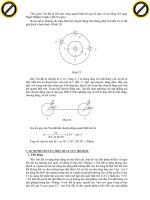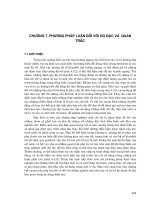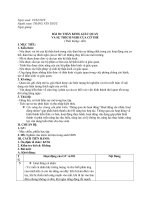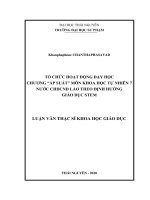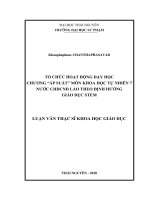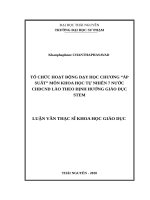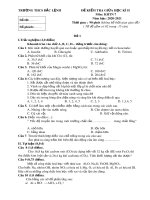Cambrige Science grade 7 level green_sách cambrige khoa học tự nhiên khối7
Bạn đang xem bản rút gọn của tài liệu. Xem và tải ngay bản đầy đủ của tài liệu tại đây (85.38 MB, 926 trang )
interactive student edition
Level Green
These ocean cliffs on the
Victoria coast in Australia
are called the Twelve Apostles.
They form a background for
wild horses running through
a field. The inset photo is a
model of an aspirin molecule.
These elements represent the
Earth, life, and physical
sciences, respectively.
Copyright © 2008 by The McGraw-Hill Companies, Inc. All rights reserved. Except as permitted under
the United States Copyright Act, no part of this publication may be reproduced or distributed in any
form or by any means, or stored in a database or retrieval system, without prior written permission
of the publisher.
The National Geographic features were designed and developed by the National Geographic Society’s
Education Division. Copyright © National Geographic Society.The name “National Geographic Society”
and the Yellow Border Rectangle are trademarks of the Society, and their use, without prior written
permission, is strictly prohibited.
The “Science and Society” and the “Science and History” features that appear in this book were
designed and developed by TIME School Publishing, a division of TIME Magazine.TIME and the red
border are trademarks of Time Inc. All rights reserved.
Send all inquiries to:
Glencoe/McGraw-Hill
8787 Orion Place
Columbus, OH 43240-4027
ISBN: 978-0-07-877808-7
MHID: 0-07-877808-5
Printed in the United States of America.
1 2 3 4 5 6 7 8 9 10 079/043 09 08 07
Contents
In Brief
Earth’s Materials . . . . . . . . . . . . . . . . . . . . . . . . . . . . . . . . . . . . . . . . 2 Contents In Brief
Chapter 1 The Nature of Science. . . . . . . . . . . . . . . . . . . . . . . . . . . . . . . . . . 4
Chapter 2 Minerals . . . . . . . . . . . . . . . . . . . . . . . . . . . . . . . . . . . . . . . . . . . . 28
Chapter 3 Rocks . . . . . . . . . . . . . . . . . . . . . . . . . . . . . . . . . . . . . . . . . . . . . . 56
Earth’s Atmosphere and Beyond . . . . . . . . . . . . . . . . . . . . . . . . . . . . . . . . . 86
Chapter 4 Atmosphere . . . . . . . . . . . . . . . . . . . . . . . . . . . . . . . . . . . . . . . . . 88
Chapter 5 Weather . . . . . . . . . . . . . . . . . . . . . . . . . . . . . . . . . . . . . . . . . . . 116
Chapter 6 Climate . . . . . . . . . . . . . . . . . . . . . . . . . . . . . . . . . . . . . . . . . . . . 146
Chapter 7 Earth in Space . . . . . . . . . . . . . . . . . . . . . . . . . . . . . . . . . . . . . . 176
The Basis of Life . . . . . . . . . . . . . . . . . . . . . . . . . . . . . . . . . . . . . . . . . . . . . . . 210
Chapter 8 Life’s Structure and Classification . . . . . . . . . . . . . . . . . . . . . . 212
Chapter 9 Cell Processes. . . . . . . . . . . . . . . . . . . . . . . . . . . . . . . . . . . . . . . 244
Chapter 10 Cell Reproduction . . . . . . . . . . . . . . . . . . . . . . . . . . . . . . . . . . . 274
Chapter 11 Heredity . . . . . . . . . . . . . . . . . . . . . . . . . . . . . . . . . . . . . . . . . . . 304
Chapter 12 Adaptations over Time . . . . . . . . . . . . . . . . . . . . . . . . . . . . . . . 332
Human Body Systems . . . . . . . . . . . . . . . . . . . . . . . . . . . . . . . . . . . . . . . . . . 362
Chapter 13 Circulation and Immunity . . . . . . . . . . . . . . . . . . . . . . . . . . . . 364
Chapter 14 Digestion, Respiration, and Excretion. . . . . . . . . . . . . . . . . . . 398
Chapter 15 Support, Movement, and Responses . . . . . . . . . . . . . . . . . . . . 432
Chapter 16 Regulation and Reproduction . . . . . . . . . . . . . . . . . . . . . . . . . 466
The Interdependence of Life. . . . . . . . . . . . . . . . . . . . . . . . . . . . . . . . . . . . 496
Chapter 17 Plants . . . . . . . . . . . . . . . . . . . . . . . . . . . . . . . . . . . . . . . . . . . . . 498
Chapter 18 Interactions of Living Things. . . . . . . . . . . . . . . . . . . . . . . . . . 530
Chapter 19 Conserving Resources . . . . . . . . . . . . . . . . . . . . . . . . . . . . . . . 558
Matter and Energy. . . . . . . . . . . . . . . . . . . . . . . . . . . . . . . . . . . . . . . . . . . . . 590
Chapter 20 Properties and Changes of Matter. . . . . . . . . . . . . . . . . . . . . . 592
Chapter 21 Substances, Mixtures, and Solubility. . . . . . . . . . . . . . . . . . . . 618
Chapter 22 States of Matter . . . . . . . . . . . . . . . . . . . . . . . . . . . . . . . . . . . . . 650
Chapter 23 Newton’s Laws of Motion. . . . . . . . . . . . . . . . . . . . . . . . . . . . . 682
Chapter 24 Energy and Energy Resources . . . . . . . . . . . . . . . . . . . . . . . . . 714
iii
Education Division Authors
Washington, D.C.
Edward Ortleb
Alton Biggs
Science Consultant
Biology Teacher St. Louis, MO
Allen High School
Peter Rillero, PhD
Allen, TX
Associate Professor of Science Education
Lucy Daniel, PhD Arizona State University West
Phoenix, AZ
Teacher/Consultant
Rutherford County Schools Susan Leach Snyder
Rutherfordton, NC Retired Teacher/Consultant
Jones Middle School
Ralph M. Feather Jr., PhD Upper Arlington, OH
Assistant Professor Dinah Zike
Department of Educational Studies
Educational Consultant
and Secondary Education Dinah-Might Activities, Inc.
Bloomsburg University
Bloomsburg, PA San Antonio, TX
Series Consultants
CONTENT
Alton J. Banks, PhD Michael A. Hoggarth, PhD Linda McGaw
Director of the Faculty Center Department of Life and Science Program Coordinator
Earth Sciences Advanced Placement Strategies, Inc.
for Teaching and Learning Otterbein College
North Carolina State University Westerville, OH Dallas, TX
Raleigh, NC Jerome A. Jackson, PhD Madelaine Meek
Whitaker Eminent Scholar in Science Physics Consultant Editor
Jack Cooper
Ennis High School Program Director Lebanon, OH
Center for Science, Mathematics,
Ennis, TX Robert Nierste
and Technology Education Science Department Head
Sandra K. Enger, PhD Florida Gulf Coast University Hendrick Middle School, Plano ISD
Associate Director,
Associate Professor Fort Meyers, FL Plano, TX
UAH Institute for Science Education William C. Keel, PhD Connie Rizzo, MD, PhD
Huntsville, AL Department of Physics Department of Science/Math
Marymount Manhattan College
David G. Haase, PhD and Astronomy
North Carolina State University University of Alabama New York, NY
Raleigh, NC Tuscaloosa, AL
iv
Dominic Salinas, PhD READING SAFETY
Middle School Science Supervisor
Elizabeth Babich Aileen Duc, PhD
Caddo Parish Schools Special Education Teacher Science 8 Teacher
Shreveport, LA Mashpee Public Schools Hendrick Middle School, Plano ISD
Cheryl Wistrom Mashpee, MA Plano, TX
St. Joseph’s College
Barry Barto Sandra West, PhD
Rensselaer, IN Special Education Teacher Department of Biology
John F. Kennedy Elementary Texas State University-San Marcos
Carl Zorn, PhD
Staff Scientist Manistee, MI San Marcos, TX
Jefferson Laboratory Carol A. Senf, PhD ACTIVITY TESTERS
Newport News, VA School of Literature,
Communication, and Culture Nerma Coats Henderson
MATH Georgia Institute of Technology Pickerington Lakeview Jr. High
Michael Hopper, DEng. Atlanta, GA School
Manager of Aircraft Certification Pickerington, OH
Rachel Swaters-Kissinger
L-3 Communications Science Teacher Mary Helen Mariscal-Cholka
Greenville, TX William D. Slider Middle School
John Boise Middle School
Teri Willard, EdD Warsaw, MO El Paso, TX
Mathematics Curriculum Writer
Science Kit and Boreal
Belgrade, MT Laboratories
Tonawanda, NY
Deidre Adams Reviewers Karen Curry
West Vigo Middle School East Wake Middle School
William Blair
West Terre Haute, IN Retired Teacher Raleigh, NC
J. Marshall Middle School
Sharla Adams Billerica, MA Joanne Davis
IPC Teacher Murphy High School
Tom Bright
Allen High School Concord High School Murphy, NC
Allen, TX
Charlotte, NC Robin Dillon
Maureen Barrett Hanover Central High School
Thomas E. Harrington Middle School Lois Burdette
Green Bank Elementary-Middle Cedar Lake, IN
Mt. Laurel, NJ
School Anthony J. DiSipio, Jr.
John Barry Green Bank, WV 8th Grade Science
Seeger Jr.-Sr. High School
Marcia Chackan Octorana Middle School
West Lebanon, IN Pine Crest School Atglen, PA
Boca Raton, FL
Desiree Bishop Sandra Everhart
Environmental Studies Center Obioma Chukwu Dauphin/Enterprise Jr. High Schools
Mobile County Public Schools J.H. Rose High School
Enterprise, AL
Mobile, AL Greenville, NC
v
Mary Ferneau Michael Mansour Mark Sailer
Westview Middle School Board Member Pioneer Jr.-Sr. High School
Goose Creek, SC National Middle Level Science Royal Center, IN
Teacher’s Association
Cory Fish Joanne Stickney
Burkholder Middle School John Page Middle School Monticello Middle School
Madison Heights, MI
Henderson, NV Monticello, NY
Mary Helen Mariscal-Cholka
Linda V. Forsyth William D. Slider Middle School Dee Stout
Retired Teacher Penn State University
El Paso, TX University Park, PA
Merrill Middle School
Denver, CO Michelle Mazeika Darcy Vetro-Ravndal
Whiting Middle School Hillsborough High School
George Gabb
Great Bridge Middle School Whiting, IN Tampa, FL
Chesapeake Public Schools
Joe McConnell Karen Watkins
Chesapeake, VA Speedway Jr. High School Perry Meridian Middle School
Annette D’Urso Garcia Indianapolis, IN Indianapolis, IN
Kearney Middle School
Commerce City, CO Sharon Mitchell Clabe Webb
William D. Slider Middle School Permian High School
Nerma Coats Henderson
Pickerington Lakeview Jr. El Paso, TX Ector County ISD
High School Odessa, TX
Pickerington, OH Amy Morgan
Berry Middle School Alison Welch
Lynne Huskey William D. Slider Middle School
Chase Middle School Hoover, AL
El Paso, TX
Forest City, NC Norma Neely, EdD
Associate Director for Regional Kim Wimpey
Maria E. Kelly North Gwinnett High School
Principal Projects
Texas Rural Systemic Initiative Suwanee, GA
Nativity School
Catholic Diocese of Arlington Austin, TX Kate Ziegler
Durant Road Middle School
Burke, VA Annette Parrott
Lakeside High School Raleigh, NC
Atlanta, GA
Nora M. Prestinari Burchett
Saint Luke School
McLean, VA
vi
Teacher Advisory Board
The Teacher Advisory Board gave the authors, editorial staff, and design team feedback
on the content and design of the Student Edition. They provided valuable input in the
development of the 2008 edition of Glencoe Science Level Green.
John Gonzales Marie Renner Rubidel Peoples
Challenger Middle School Diley Middle School Meacham Middle School
Tucson, AZ Pickerington, OH Fort Worth, TX
Rachel Shively Nelson Farrier Kristi Ramsey
Aptakisic Jr. High School Hamlin Middle School Navasota Jr. High School
Buffalo Grove, IL Springfield, OR Navasota, TX
Roger Pratt Jeff Remington
Manistique High School Palmyra Middle School
Manistique, MI Palmyra, PA
Kirtina Hile Erin Peters
Northmor Jr. High/High School Williamsburg Middle School
Galion, OH Arlington, VA
Student Advisory Board
The Student Advisory Board gave the authors, editorial staff, and design team feedback
on the design of the Student Edition. We thank these students for their hard work and
creative suggestions in making the 2008 edition of Glencoe Science Level Green student
friendly.
Jack Andrews Addison Owen
Reynoldsburg Jr. High School Davis Middle School
Reynoldsburg, OH Dublin, OH
Peter Arnold Teriana Patrick
Hastings Middle School Eastmoor Middle School
Upper Arlington, OH Columbus, OH
Emily Barbe Ashley Ruz
Perry Middle School Karrar Middle School
Worthington, OH Dublin, OH
Kirsty Bateman
Hilliard Heritage Middle School
Hilliard, OH
Andre Brown
Spanish Emersion Academy
Columbus, OH
Chris Dundon The Glencoe middle school science Student
Heritage Middle School Advisory Board taking a timeout at COSI,
Westerville, OH a science museum in Columbus, Ohio.
Ryan Manafee
Monroe Middle School
Columbus, OH
vii
Why do I need Before You Read
my science book?
G Chapter Opener Science is occurring all around you,
Have you ever been in class and and the opening photo of each chapter will preview the
not understood all of what was science you will be learning about. The Chapter
presented? Or, you understood Preview will give you an idea of what you will be
everything in class, but at home, learning about, and you can try the Launch Lab to
got stuck on how to answer a help get your brain headed in the right direction. The
question? Maybe you just Foldables exercise is a fun way to keep you organized.
wondered when you were ever
going to use this stuff? G Section Opener Chapters are divided into two to four
sections. The As You Read in the margin of the first
These next few pages page of each section will let you know what is most
are designed to help you important in the section. It is divided into four parts.
understand everything your What You’ll Learn will tell you the major topics you
science book can be used will be covering. Why It’s Important will remind you
for . . . besides a paperweight! why you are studying this in the first place! The
Review Vocabulary word is a word you already know,
either from your science studies or your prior knowl-
edge. The New Vocabulary words are words that you
need to learn to understand this section. These words
will be in boldfaced print and highlighted in the
section. Make a note to yourself to recognize these
words as you are reading the section.
Science Vocabulary Make the
following Foldable to help you
understand the vocabulary
terms in this chapter.
As You Read STEP 1 Fold a vertical
sheet of notebook
G Headings Each section has a title paper from side to
in large red letters, and is further side.
divided into blue titles and
small red titles at the begin- STEP 2 Cut along every third line of only the
nings of some paragraphs. top layer to form tabs.
To help you study, make an
outline of the headings and STEP 3 Label each tab with a vocabulary
subheadings. word from the chapter.
G Margins In the margins of Build Vocabulary As you read the chapter, list
your text, you will find many helpful the vocabulary words on the tabs. As you learn
resources. The Science Online exercises and the definitions, write them under the tab for
Integrate activities help you explore the topics each vocabulary word.
you are studying. MiniLabs reinforce the sci-
ence concepts you have learned. Look For...
G Building Skills You also will find an At the beginning of
Applying Math or Applying Science activity every section.
in each chapter. This gives you extra prac-
tice using your new knowledge, and helps
prepare you for standardized tests.
G Student Resources At the end of the book
you will find Student Resources to help you
throughout your studies. These include
Science, Technology, and Math Skill Hand-
books, an English/Spanish Glossary, and an
Index. Also, use your Foldables as a resource.
It will help you organize information, and
review before a test.
G In Class Remember, you can always
ask your teacher to explain anything
you don’t understand.
ix
In Lab
Working in the laboratory is one of the best ways to understand the con-
cepts you are studying. Your book will be your guide through your laboratory
experiences, and help you begin to think like a scientist. In it, you not only will
find the steps necessary to follow the investigations, but you also will find
helpful tips to make the most of your time.
G Each lab provides you with a Real-World Question to remind you that
science is something you use every day, not just in class. This may lead
to many more questions about how things happen in your world.
G Remember, experiments do not always produce the result you expect.
Scientists have made many discoveries based on investigations with unex-
pected results. You can try the experiment again to make sure your results
were accurate, or perhaps form a new hypothesis to test.
G Keeping a Science Journal is how scientists keep accurate records of obser-
vations and data. In your journal, you also can write any questions that
may arise during your investigation. This is a great method of reminding
yourself to find the answers later.
x
Before a Test
Admit it! You don’t like to take tests! However, there are
ways to review that make them less painful. Your book will
help you be more successful taking tests if you use the
resources provided to you.
G Review all of the New Vocabulary words and be sure you
understand their definitions.
G Review the notes you’ve taken on your Foldables, in class,
and in lab. Write down any question that you still need
answered.
G Review the Summaries and Self Check questions at the
end of each section.
G Study the concepts presented in the chapter by reading
the Study Guide and answering the questions in
the Chapter Review.
Look For...
G Reading Checks and caption
questions throughout the text.
G the Summaries and Self Check
questions at the end of each section.
G the Study Guide and Review
at the end of each chapter.
G the Standardized Test Practice
after each chapter.
xi
Let’s Get Started
To help you find the information you need quickly, use the Scavenger
Hunt below to learn where things are located in Chapter 1.
What is the title of this chapter?
What will you learn in Section 1?
Sometimes you may ask, “Why am I learning this?” State a reason why the
concepts from Section 2 are important.
What is the main topic presented in Section 2?
How many reading checks are in Section 1?
What is the Web address where you can find extra information?
What is the main heading above the sixth paragraph in Section 2?
There is an integration with another subject mentioned in one of the margins
of the chapter. What subject is it?
List the new vocabulary words presented in Section 2.
List the safety symbols presented in the first Lab.
Where would you find a Self Check to be sure you understand the section?
Suppose you’re doing the Self Check and you have a question about concept
mapping. Where could you find help?
On what pages are the Chapter Study Guide and Chapter Review?
Look in the Table of Contents to find out on which page Section 2 of the
chapter begins.
You complete the Chapter Review to study for your chapter test.
Where could you find another quiz for more practice?
xii
Contents
Earth’s Materials—2 Contents
Section 1 The Nature of Science—4 In each chapter, look for
Section 2 these opportunities for
How Science Works . . . . . . . . . . . . . . . . . . . . . . . . . .6 review and assessment:
Scientific Problem Solving . . . . . . . . . . . . . . . . . . .12 • Reading Checks
Lab Advertising Inferences . . . . . . . . . . . . . . . . . . .19 • Caption Questions
Lab Model an Archaeological Dig . . . . . . . . . . . . .20 • Section Review
• Chapter Study Guide
Section 1 Minerals—28 • Chapter Review
• Standardized Test
Section 2 Minerals . . . . . . . . . . . . . . . . . . . . . . . . . . . . . . . . . .30
Section 3 Lab Crystal Formation . . . . . . . . . . . . . . . . . . . . . .34 Practice
Mineral Identification . . . . . . . . . . . . . . . . . . . . . . .35 • Online practice at
Uses of Minerals . . . . . . . . . . . . . . . . . . . . . . . . . . .41
Lab: Design Your Own green.msscience.com
Mineral Identification . . . . . . . . . . . . . . . . . . . . . .48 Get Ready to Read
Strategies
Rocks—56 • Preview . . . . . . . . . . 6A
• New
The Rock Cycle . . . . . . . . . . . . . . . . . . . . . . . . . . . . .58
Igneous Rocks . . . . . . . . . . . . . . . . . . . . . . . . . . . . .62 Vocabulary . . . . . . 30A
Lab Igneous Rock Clues . . . . . . . . . . . . . . . . . . . . .66 • Monitor . . . . . . . . . 58A
Metamorphic Rocks . . . . . . . . . . . . . . . . . . . . . . . .67
Section 1 Sedimentary Rocks . . . . . . . . . . . . . . . . . . . . . . . . .71
Section 2 Lab Sedimentary Rocks . . . . . . . . . . . . . . . . . . . . .78
Section 3
Section 4
xiii
Contents
Contents Earth’s Atmosphere and
Beyond—86
Section 1 Atmosphere—88 In each chapter, look for
these opportunities for
Section 2 Earth’s Atmosphere . . . . . . . . . . . . . . . . . . . . . . . . .90 review and assessment:
Section 3 Lab Evaluating Sunscreens . . . . . . . . . . . . . . . . . . .98 • Reading Checks
Energy Transfer in the Atmosphere . . . . . . . . . . .99 • Caption Questions
Air Movement . . . . . . . . . . . . . . . . . . . . . . . . . . . .103 • Section Review
Lab: Design Your Own • Chapter Study Guide
• Chapter Review
The Heat is On . . . . . . . . . . . . . . . . . . . . . . . . . . .108 • Standardized Test
Weather—116 Practice
• Online practice at
What is weather? . . . . . . . . . . . . . . . . . . . . . . . . . .118
Weather Patterns . . . . . . . . . . . . . . . . . . . . . . . . . .126 green.msscience.com
Weather Forecasts . . . . . . . . . . . . . . . . . . . . . . . . .134
Section 1 Lab Reading a Weather Map . . . . . . . . . . . . . . . .137
Section 2 Lab: Model and Invent
Section 3
Measuring Wind Speed . . . . . . . . . . . . . . . . . . . .138
Contents
Climate—146 Get Ready to Read Contents
Strategies
Section 1 What is climate? . . . . . . . . . . . . . . . . . . . . . . . . . . .148 • Identify the
Section 2 Climate Types . . . . . . . . . . . . . . . . . . . . . . . . . . . . .152
Section 3 Climatic Changes . . . . . . . . . . . . . . . . . . . . . . . . . .156 Main Idea . . . . . . . 90A
Lab The Greenhouse Effect . . . . . . . . . . . . . . . . .167 • New
Lab Microclimates . . . . . . . . . . . . . . . . . . . . . . . . .168
Vocabulary . . . . . 118A
Earth in Space—176 • Monitor . . . . . . . . 148A
• Make
Earth’s Motions and Seasons . . . . . . . . . . . . . . . .178
Earth’s Moon . . . . . . . . . . . . . . . . . . . . . . . . . . . . .184 Predictions . . . . 178A
Lab Viewing the Moon . . . . . . . . . . . . . . . . . . . .193 • Identify Cause
Our Solar System . . . . . . . . . . . . . . . . . . . . . . . . . .194
Lab: Model and Invent and Effect . . . . . . 214A
Section 1 The Slant of the Sun’s Rays . . . . . . . . . . . . . . . . .202
Section 2
Section 3
The Basis of Life—210
Section 1 Life’s Structure and
Section 2 Classification—212
Section 3
Living Things . . . . . . . . . . . . . . . . . . . . . . . . . . . . .214
Section 4 How are living things classified? . . . . . . . . . . . . .218
Cell Structure . . . . . . . . . . . . . . . . . . . . . . . . . . . . .221
Lab Comparing Cells . . . . . . . . . . . . . . . . . . . . . .231
Viruses . . . . . . . . . . . . . . . . . . . . . . . . . . . . . . . . . . .232
Lab: Design Your Own
Comparing Light Microscopes . . . . . . . . . . . . . .236
xv
Contents
Contents Cell Processes—244
Section 1 Chemistry of Life . . . . . . . . . . . . . . . . . . . . . . . . . .246
Section 2 Moving Cellular Materials . . . . . . . . . . . . . . . . . .254
Lab Observing Osmosis . . . . . . . . . . . . . . . . . . . .260
Section 3 Energy of Life . . . . . . . . . . . . . . . . . . . . . . . . . . . . .261
Lab Photosynthesis and Respiration . . . . . . . . . .266
Section 1 Cell Reproduction—274
Section 2 Cell Division and Mitosis . . . . . . . . . . . . . . . . . . .276
Section 3 Lab Mitosis in Plant Cells . . . . . . . . . . . . . . . . . . .283
Sexual Reproduction and Meiosis . . . . . . . . . . . .284
DNA . . . . . . . . . . . . . . . . . . . . . . . . . . . . . . . . . . . . .290
Lab: Use the Internet
Mutations . . . . . . . . . . . . . . . . . . . . . . . . . . . . . . .296
Section 1 Heredity—304
Section 2 Genetics . . . . . . . . . . . . . . . . . . . . . . . . . . . . . . . . . .306
Section 3 Lab Predicting Results . . . . . . . . . . . . . . . . . . . . .313
Genetics Since Mendel . . . . . . . . . . . . . . . . . . . . .314
Advances in Genetics . . . . . . . . . . . . . . . . . . . . . .321 In each chapter, look for
Lab: Design Your Own these opportunities for
review and assessment:
Tests for Color Blindness . . . . . . . . . . . . . . . . . .324 • Reading Checks
• Caption Questions
Section 1 Adaptations over Time—332 • Section Review
• Chapter Study Guide
Section 2 Ideas About Evolution . . . . . . . . . . . . . . . . . . . . . .334 • Chapter Review
Section 3 Lab Hidden Frogs . . . . . . . . . . . . . . . . . . . . . . . . .342 • Standardized Test
Clues About Evolution . . . . . . . . . . . . . . . . . . . . .343
The Evolution of Primates . . . . . . . . . . . . . . . . . .350 Practice
Lab: Design Your Own • Online practice at
Recognizing Variation in a Population . . . . . . .354 green.msscience.com
xvi
Contents
Human Body Contents
Systems—362
Section 1 Circulation and Immunity—364 Get Ready to Read
Section 2 Strategies
Section 3 Blood . . . . . . . . . . . . . . . . . . . . . . . . . . . . . . . . . . . .366 • New
Section 4 Circulation . . . . . . . . . . . . . . . . . . . . . . . . . . . . . . .371
Immunity . . . . . . . . . . . . . . . . . . . . . . . . . . . . . . . .377 Vocabulary . . . . . 246A
Diseases . . . . . . . . . . . . . . . . . . . . . . . . . . . . . . . . . .381 • Monitor . . . . . . . . 276A
Lab Microorganisms of Disease . . . . . . . . . . . . . .389 • Visualize . . . . . . . 306A
Lab: Design Your Own • Question . . . . . . . 334A
• Summarize . . . . 366A
Blood Types . . . . . . . . . . . . . . . . . . . . . . . . . . . . .390 • Compare and
Digestion, Respiration, and Contrast . . . . . . . 400A
Excretion—398 • Make
The Digestive System . . . . . . . . . . . . . . . . . . . . . .400 Inferences . . . . . 434A
Nutrition . . . . . . . . . . . . . . . . . . . . . . . . . . . . . . . . .405
Section 1 Lab Identifying Vitamin C Content . . . . . . . . . . .411
Section 2 The Respiratory System . . . . . . . . . . . . . . . . . . . .412
The Excretory System . . . . . . . . . . . . . . . . . . . . . .419
Section 3 Lab Particle Size and Absorption . . . . . . . . . . . . .424
Section 4
Section 1 Support, Movement, and
Responses—432
Section 2
Section 3 The Skin . . . . . . . . . . . . . . . . . . . . . . . . . . . . . . . . .434
Section 4 Lab Measuring Skin Surface . . . . . . . . . . . . . . . . .438
The Muscular System . . . . . . . . . . . . . . . . . . . . . .439
The Skeletal System . . . . . . . . . . . . . . . . . . . . . . . .444
The Nervous System . . . . . . . . . . . . . . . . . . . . . . .449
Lab: Design Your Own
Skin Sensitivity . . . . . . . . . . . . . . . . . . . . . . . . . . .458
xvii
Contents
Contents Regulation and Reproduction—466
Section 1 The Endocrine System . . . . . . . . . . . . . . . . . . . . .468
Section 2 The Reproductive System . . . . . . . . . . . . . . . . . . .473
Lab Interpreting Diagrams . . . . . . . . . . . . . . . . . .478
Section 3 Human Life Stages . . . . . . . . . . . . . . . . . . . . . . . . .479
Lab Changing Body Proportions . . . . . . . . . . . . .488
The Interdependence
of Life—496
Section 1 Plants—498
Section 2
Section 3 An Overview of Plants . . . . . . . . . . . . . . . . . . . . .500
Seedless Plants . . . . . . . . . . . . . . . . . . . . . . . . . . . .506
Seed Plants . . . . . . . . . . . . . . . . . . . . . . . . . . . . . . .512 Get Ready to Read
Lab Identifying Conifers . . . . . . . . . . . . . . . . . . . .521 Strategies
Lab: Use the Internet • Make
Plants as Medicine . . . . . . . . . . . . . . . . . . . . . . . .522 Connections . . . . 468A
• Make
Section 1 Interactions of Living Things—530
Connections . . . . 500A
Section 2 The Environment . . . . . . . . . . . . . . . . . . . . . . . . . .532 • Take Notes . . . . . 532A
Section 3 Lab Delicately Balanced Ecosystems . . . . . . . . . .538 • Questions and
Interactions Among Living Organisms . . . . . . .539
Matter and Energy . . . . . . . . . . . . . . . . . . . . . . . . .544 Answers . . . . . . . 560A
Lab: Design Your Own • New
Identifying a Limiting Factor . . . . . . . . . . . . . . .550 Vocabulary . . . . . 594A
• Identify Cause
and Effect . . . . . . 620A
xviii
Contents
Conserving Resources—558 In each chapter, look for Contents
these opportunities for
Section 1 Resources . . . . . . . . . . . . . . . . . . . . . . . . . . . . . . . .560 review and assessment:
Section 2 Pollution . . . . . . . . . . . . . . . . . . . . . . . . . . . . . . . . .568 • Reading Checks
Lab The Greenhouse Effect . . . . . . . . . . . . . . . . .577 • Caption Questions
Section 3 The Three Rs of Conservation . . . . . . . . . . . . . . .578 • Section Review
Lab: Model and Invent • Chapter Study Guide
• Chapter Review
Solar Cooking . . . . . . . . . . . . . . . . . . . . . . . . . . .582 • Standardized Test
Matter and Practice
Energy—590 • Online practice at
green.msscience.com
Section 1 Properties and Changes
Section 2 of Matter—592
Physical and Chemical Properties . . . . . . . . . . . .594
Lab Finding the Difference . . . . . . . . . . . . . . . . . .599
Physical and Chemical Changes . . . . . . . . . . . . .600
Lab: Design Your Own
Battle of the Toothpastes . . . . . . . . . . . . . . . . . . .610
Section 1 Substances, Mixtures, and
Section 2 Solubility—618
Section 3 What is a solution? . . . . . . . . . . . . . . . . . . . . . . . .620
Solubility . . . . . . . . . . . . . . . . . . . . . . . . . . . . . . . . .626
Lab Observing Gas Solubility . . . . . . . . . . . . . . .633
Acidic and Basic Solutions . . . . . . . . . . . . . . . . . .634
Lab Testing pH Using Natural Indicators . . . . . .642
xix
